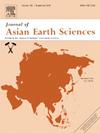Linking hydrothermal He-CO2 degassing to regional seismicity in the volcanically and tectonically active Tengchong block, southeastern Tibetan Plateau
IF 2.7
3区 地球科学
Q2 GEOSCIENCES, MULTIDISCIPLINARY
引用次数: 0
Abstract
The volcanically and tectonically active regions are manifest by the co-existence of hydrothermal degassing and seismic activities, but the potential links between them remain enigmatic. Here, we present flux estimates for hydrothermal He and CO2 from the Tengchong block, southeastern Tibetan Plateau, to constrain the role of magmatic fluids in triggering earthquakes. The He-CO2 systematics reveal significant anomalies of mantle He and CO2 degassing in localized volcanically active regions (VAR) that are superposed upon a broader tectonically active region (TAR).This correlates well with geophysically detected melts at crustal depths and suggests focused supply of magmatic fluids to hydrothermal system. Higher fluxes of mantle He [(1.08 ± 0.84) × 1010 atoms m−2 s−1] and CO2 [(1.29 ± 1.00) × 104 mol km−2 yr−1] of magmatic origins concentrate in the VAR rather than the TAR [mantle He and CO2 flux = (0.26 ± 0.16) × 1010 atoms m−2 s−1 and (0.32 ± 0.19) × 104 mol km−2 yr−1, respectively]. Spatially, high magmatic He-CO2 fluxes in the VAR correspond well with several earthquake swarms and deep low-frequency earthquakes, while the TAR with much lower fluxes of magmatic fluids generally hosts tectonic earthquakes that align along active faults. These observations offer plausible evidence for the crucial role of magmatic fluids in causing overpressure in seismogenic zone beneath the VAR, which differs from stress-dominated earthquake nucleation in the TAR, suggesting the interplay between magmatic fluids and tectonic faulting in driving regional seismicity.
求助全文
约1分钟内获得全文
求助全文
来源期刊

Journal of Asian Earth Sciences
地学-地球科学综合
CiteScore
5.90
自引率
10.00%
发文量
324
审稿时长
71 days
期刊介绍:
Journal of Asian Earth Sciences has an open access mirror journal Journal of Asian Earth Sciences: X, sharing the same aims and scope, editorial team, submission system and rigorous peer review.
The Journal of Asian Earth Sciences is an international interdisciplinary journal devoted to all aspects of research related to the solid Earth Sciences of Asia. The Journal publishes high quality, peer-reviewed scientific papers on the regional geology, tectonics, geochemistry and geophysics of Asia. It will be devoted primarily to research papers but short communications relating to new developments of broad interest, reviews and book reviews will also be included. Papers must have international appeal and should present work of more than local significance.
The scope includes deep processes of the Asian continent and its adjacent oceans; seismology and earthquakes; orogeny, magmatism, metamorphism and volcanism; growth, deformation and destruction of the Asian crust; crust-mantle interaction; evolution of life (early life, biostratigraphy, biogeography and mass-extinction); fluids, fluxes and reservoirs of mineral and energy resources; surface processes (weathering, erosion, transport and deposition of sediments) and resulting geomorphology; and the response of the Earth to global climate change as viewed within the Asian continent and surrounding oceans.
 求助内容:
求助内容: 应助结果提醒方式:
应助结果提醒方式:


